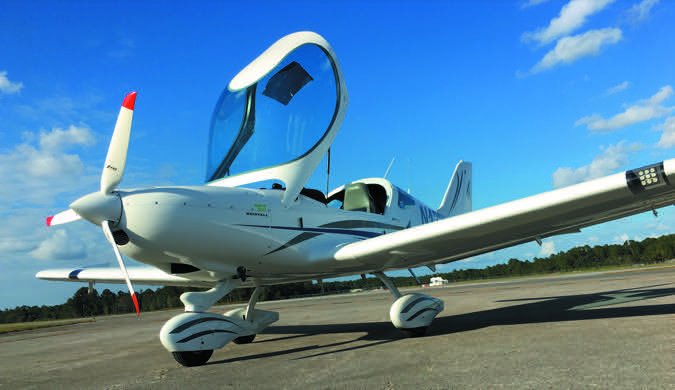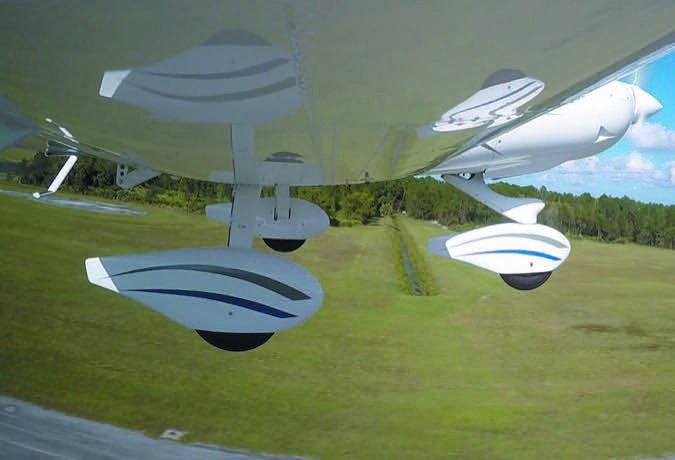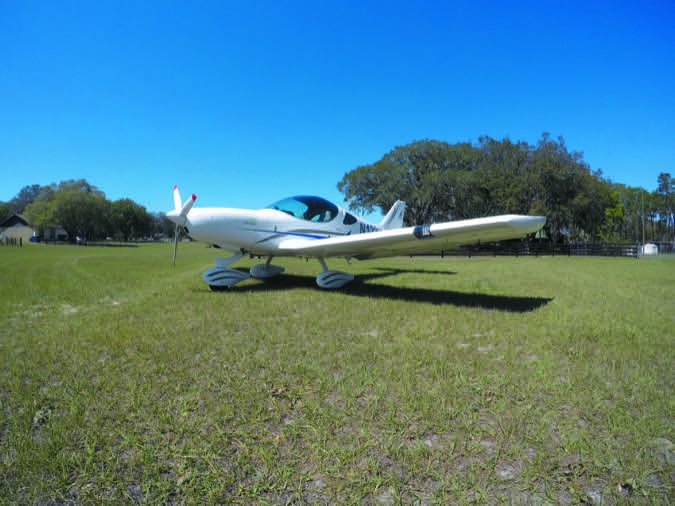Is there a value proposition in an airplane that cruises two-thirds as fast as a near million-dollar Cirrus, uses only one-quarter the fuel and costs one-fifth as much? The Bristell LSA, an Eastern European import we’re examining here, certainly tests the notion.
Like the Tecnam Astore we reviewed in the January 2017 issue, the Bristell NG5 stretches the slow-simple-cheap ethos of the light sport airplane to the breaking point. Given its sophisticated avionics, high cruising speed and attention to interior and baggage space, the Bristell is clearly conceived as a high-end traveling machine, not a bump-around-the-pattern flivver.
The airplane is available in three variants: the tri-gear version we flew for this review, a tailwheel model (the TD) and even a retractable gear version that’s unlikely to ever see the light of day in the U.S., except as an experimental. Base price is $126,900, but more realistically, the invoices hover around $180,000 and up.
After the Fall
It’s fair to say that the Bristell springs from the rich tradition of aircraft manufacturing left behind in the Eastern Bloc countries after the fall of the Soviet Union. By our count, there are at least nine extant sport aircraft manufacturers in the Czech Republic and, if not thriving, they appear to be holding their own.
The Bristell is the creation of designer Milan Bristela and if the airplane bears a resemblance to the Czech Sport Aircraft SportCruiser, which Piper introduced briefly as the PiperSport, it’s no coincidence. Bristela was involved in the design of that aircraft, too.
Both the Bristell and the SportCruiser are all-metal—or at least mostly metal—low-wing aircraft with bubble canopies and a low-slung sporty look. They look enough alike to be mistaken for the same aircraft, but they’re actually considerably different, according to Lou Mancuso, a veteran Long Island FBO who’s now importing the aircraft to the U.S. through the Lancaster, Pennsylvania-based Bristell Aircraft.

The Bristell NG5 has a shorter wingspan—26.8 feet vs. 28.2 feet for the SportCruiser—a wider cabin and is slightly shorter than the Cruiser. But the biggest difference is in comparative weight and useful load. At 675 pounds, best case, the Bristell is one of the lightest LSAs on the market and is much lighter than the 855-pound SportCruiser. (The version flown for this flight trial weighed 777 pounds.) Consider the useful load against the standard 1320-pound LSA max gross weight. The airplane I flew had a 543-pound useful load compared to about 465 pounds for the SportCruiser. Throw in full fuel (32 gallons) and the Bristell has 351 pounds of payload left—two people if they aren’t too heavy. If the occupants are broad shouldered, they’ll have a bunch more lateral room than they would expect in a Cessna 150. With a 51-inch cabin width and a console in between, there’s no bumping of shoulders. Legroom, while adequate, is less impressive. Anyone much over six feet may feel cramped. Adjustments are handled via sliding rudder pedals and shuffling the seat cushions.
A Little Traveling Music
One thing is obvious about the Bristell: While it may be cheap to fly and suitable for 30-mile breakfast flights, the designer appears to have more ambitious flying in mind. For one thing, the airplane is fast. Without trying very hard, I easily pushed it up to 120 knots true and suspect with prop adjustments, it has more in it. The airplane was equipped with a ground-adjustable three-blade Fiti composite prop. Available as an option is an electrical ground-adjustable prop, but it’s not adjustable in flight.
Second, the Bristell has far more sophisticated avionics than most LSAs (more on that in a moment) and storage space galore. There’s a large rear baggage compartment with a shelf and 33 pounds of capacity plus two wing lockers just inboard of the ailerons that each hold 44 pounds. Bristell offers custom-made bag liners that fit these wing lockers. That’s a lot more space than you need to meet your buddies on a Saturday morning breakfast flight so clearly, this airplane is meant to go places. With 32 gallons of fuel for six hours of endurance, it’s got the legs to get there.
The airplane I flew was equipped with the 100-HP Rotax 912 iS, but the 115-HP turbocharged 914 is also an option, as is the 100-HP 912 ULS. Mancuso told us that customers have been split between the iS and ULS options. The 912 iS is a $10,000 upgrade and burns a little less fuel, but at under 5 GPH in cruise, typically, the Bristell is already miserly on gas. With the right winds, says Mancuso, he’s made it nonstop from Florida to the northeast.
Now, back to the avionics. The version I flew was equipped with the Garmin G3X Touch, which includes an autopilot with envelope protection options. If this package is less sophisticated than what’s found in a modern Cirrus or Cessna, it’s not much so. The airplane had a pair of 10.6-inch displays that can have independent ADAHRs and a backup battery on the pilot’s side good for 20 to 30 minutes of operation. (The airplane itself also has a backup battery for the 912 iS FADEC system.) Although it’s not approved for IFR, the airplane I flew had backup gauges nonetheless, a trio of pitot-static instruments under the eyebrow and above the center display. No standby gyro, however.

Manufacturers building to the ASTM light sport standard are allowed to approve their aircraft for flight under IFR but not in IMC—Tecnam does this. Bristell hasn’t followed, but Mancuso says it’s in the works. Further, the company is exploring an E-LSA variant that would be operable in IMC under IFR. Given the reliability and sophistication of the avionics, I wouldn’t hesitate to use an airplane like this for cautious IFR in IMC. Cautious means avoiding even a hint of icing and giving thunderstorms a wide berth.
No Simple Airplane
If the FAA (and the industry) intended light sports to be modern iterations of the Piper J-3, Bristell didn’t get the memo. Neither did Tecnam and a few others. The Bristell is not a simple airplane to operate, although it’s easy enough to fly. After my second flight in the airplane, I observed to Mancuso that LSA or not, the Bristell is a true TAA—technologically advanced aircraft. He compared it to checking out in a Piper Arrow, albeit one with a glass panel.
The airplane has a longish pre-start and pre-takeoff checklist and I’d say a pilot shouldn’t gloss over it. There are checks for the backup batteries and the two lanes for the Rotax’s ignition system, plus some semi-involved step-throughs on the G3X Touch and a check that the autopilot servos can be overpowered by muscle. The Rotax has that peculiar requirement to warm up before the power can be advanced to taxi, something Lycoming operators rarely bother with.

As far as the Touch is concerned, anyone familiar with the Garmin GPSMap 396 and forward or the GTN-series navigators will adapt to its top-level functions relatively easily. It responds to random button pushing and if you know a few basics like touching tabs to bring up deeper menus, it’s not hard to drive it. High-level functions, such as flight planning and configuration setups, will require some training or manual review. A couple of hours ought to do it. It’s much easier than a G1000. The autopilot is broadly similar to the GFC 700 and, indeed, has some of the same functions, including Electronic Stability and Protection, which Garmin calls ESP-X for the Touch. Whether the autopilot is engaged or not, ESP kicks in when bank and pitch angles are out of bounds and it exerts increasing corrective control force until the exceedance is resolved. It can be manually disabled and that’s something you’d want to do when doing steep turns or stalls. The system also has the blue level button that seems to be standard these days.
As installed in experimentals and LSAs, the G3X Touch autopilot offers the choice of control solely through the touchscreens or the screens and a GMC 305 control panel. In the Bristell, it’s mounted below the center display just above the console where it’s easy to get at. I think it’s an addition worth the extra space and weight. The G3X version I flew had two 10.6-inch displays but there’s the option of 7-inch displays too or combinations. The Bristell’s panel is so large that it easily accommodates the two larger displays. Ground handling of the Bristell is superb, thanks to a steerable nosewheel. Bristell must have gotten the geometry just right because the airplane does tight taxi turns effortlessly, something many other LSAs can’t quite do. The nosegear is equipped with a dual shock absorber and the main gear legs have been beefed up to forestall landing damage.
Once past the G3X, the Rotax and autopilot complexity, the Bristell is just your standard stick-and-rudder airplane. One note: Like so many LSAs, the Bristell has light control forces, albeit probably not as light as the SportCruiser. This is a mixed bag and I prefer control forces more akin to certified aircraft because they auto damp any pilot tendency to over control. The Bristell’s forces are not so light to excite a PIO on takeoff or landing, which is definitely the case for a pilot new to the SportCruiser.

Thanks to an unrestricted bubble canopy, visibility out, up and down is terrific—almost as though there’s no canopy there at all. The top of the bubble is shaded with a composite material and panel-mount vents provide gales of air, so the cockpit didn’t seem hot on a 75-degree Florida day. The canopy itself seems improved over the SportCruiser style. You simply pull it down and a couple of overcenter latches engage two pins. To release it, there’s a lever at the aft end of the console. Unfortunately, canopy openings in flight are a prominent occurrence in the SportCruiser accident pattern. Although the airplane is flyable and controllable with the canopy open, pilots have been so distracted by an open canopy in flight that they’ve lost control of the aircraft and crashed as a result. I found only a couple of accidents involving Bristell aircraft (not this model) and no canopy openings in flight.
Slow flight and stalls in the Bristell are the usual. I didn’t notice much pitch change on flap deployment and the airplane will easily slow to a comfortable minimum of 55 knots indicated for a max-performance landing. I did notice that the nose drops through rather vigorously if the stall is aggravated to a full break. Mancuso said this won’t occur if the wings are kept level, but I didn’t notice any bank when I tried the stalls. If I were flying the airplane regularly, I’d explore this more in depth. The published stall speed in landing configuration is 39 knots. You could probably fly approaches at 50 knots and have adequate margin.
The airplane likes to get up and go. It accelerates briskly, even with two aboard, but needs to gather itself up a little before launching into a brisk climb of 800 to 900 FPM. The POH promised only 700 FPM, but I saw better than that, suggesting that this data may have been developed with a cruise setting on the prop.
Speaking of cruise, the airplane accelerates and settles down to 118 knots at about 4.5 GPH. Pushed a little harder, it will do 120 knots TAS and likely better than that at high altitude with the turbocharged 914. Mancuso says Bristell is looking at Rotax’s new 135-HP 915 iS and may offer it when it becomes available later this year or early next year.
That engine, although heavier, should dent the airplane’s useful load slightly, but in exchange for even better climb rate and cruise at altitude. It’s expected to have similar fuel economy as the 914.
Although the Bristell hasn’t been a hot seller in the U.S. yet, it’s doing we’ll in Europe and the company reports build volume of about 80 aircraft a year. So now the question is: Do buyers want this kind of performance to fly places or just to hang around the pattern doing landings? If the former, Bristell ought to find a niche larger than the one they have now, especially since no one blinks at a $200,000 LSA.
See a video about the Bristell at http://tinyurl.com/j95ht2a


